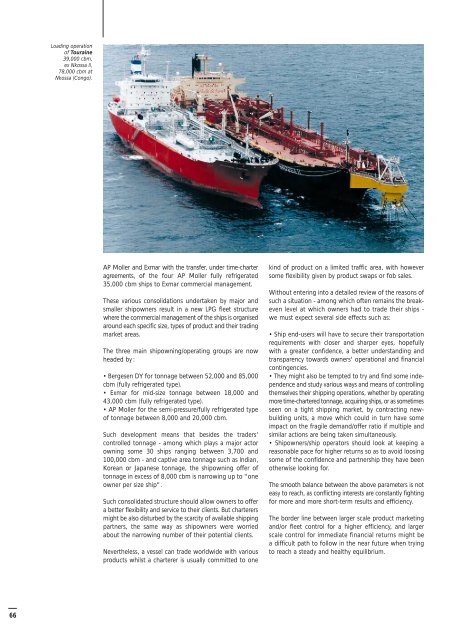Create successful ePaper yourself
Turn your PDF publications into a flip-book with our unique Google optimized e-Paper software.
66<br />
Loading operation<br />
of Touraine<br />
39,000 cbm,<br />
ex Nkossa II,<br />
78,000 cbm at<br />
Nkossa (Congo).<br />
AP Moller and Exmar with the transfer, under time-charter<br />
agreements, of the four AP Moller fully refrigerated<br />
35,000 cbm ships <strong>to</strong> Exmar commercial management.<br />
These various consolidations undertaken by major and<br />
smaller shipowners result in a new LPG fleet structure<br />
where the commercial management of the ships is organised<br />
around each specific size, types of product and their trading<br />
market areas.<br />
The three main shipowning/operating groups are now<br />
headed by :<br />
• Bergesen DY for <strong>to</strong>nnage between 52,000 and 85,000<br />
cbm (fully refrigerated type).<br />
• Exmar for mid-size <strong>to</strong>nnage between 18,000 and<br />
43,000 cbm (fully refrigerated type).<br />
• AP Moller for the semi-pressure/fully refrigerated type<br />
of <strong>to</strong>nnage between 8,000 and 20,000 cbm.<br />
Such development means that besides the traders'<br />
controlled <strong>to</strong>nnage - among which plays a major ac<strong>to</strong>r<br />
owning some 30 ships ranging between 3,700 and<br />
100,000 cbm - and captive area <strong>to</strong>nnage such as Indian,<br />
Korean or Japanese <strong>to</strong>nnage, the shipowning offer of<br />
<strong>to</strong>nnage in excess of 8,000 cbm is narrowing up <strong>to</strong> "one<br />
owner per size ship".<br />
Such consolidated structure should allow owners <strong>to</strong> offer<br />
a better flexibility and service <strong>to</strong> their clients. But charterers<br />
might be also disturbed by the scarcity of available shipping<br />
partners, the same way as shipowners were worried<br />
about the narrowing number of their potential clients.<br />
Nevertheless, a vessel can trade worldwide with various<br />
products whilst a charterer is usually committed <strong>to</strong> one<br />
kind of product on a limited traffic area, with however<br />
some flexibility given by product swaps or fob sales.<br />
Without entering in<strong>to</strong> a detailed review of the reasons of<br />
such a situation - among which often remains the breakeven<br />
level at which owners had <strong>to</strong> trade their ships -<br />
we must expect several side effects such as:<br />
• Ship end-users will have <strong>to</strong> secure their transportation<br />
requirements with closer and sharper eyes, hopefully<br />
with a greater confidence, a better understanding and<br />
transparency <strong>to</strong>wards owners' operational and financial<br />
contingencies.<br />
• They might also be tempted <strong>to</strong> try and find some independence<br />
and study various ways and means of controlling<br />
themselves their shipping operations, whether by operating<br />
more time-chartered <strong>to</strong>nnage, acquiring ships, or as sometimes<br />
seen on a tight shipping market, by contracting newbuilding<br />
units, a move which could in turn have some<br />
impact on the fragile demand/offer ratio if multiple and<br />
similar actions are being taken simultaneously.<br />
• Shipowners/ship opera<strong>to</strong>rs should look at keeping a<br />
reasonable pace for higher returns so as <strong>to</strong> avoid loosing<br />
some of the confidence and partnership they have been<br />
otherwise looking for.<br />
The smooth balance between the above parameters is not<br />
easy <strong>to</strong> reach, as conflicting interests are constantly fighting<br />
for more and more short-term results and efficiency.<br />
The border line between larger scale product marketing<br />
and/or fleet control for a higher efficiency, and larger<br />
scale control for immediate financial returns might be<br />
a difficult path <strong>to</strong> follow in the near future when trying<br />
<strong>to</strong> reach a steady and healthy equilibrium.


